Japanese Toilets: How to Use, Types, and Symbols Meaning

Confused by Japanese toilets? Our guide breaks down all the features, from how to use bidet washlets and flush buttons to understanding what each symbol means.
Toilets in Japan
Whether it be in your daily life or on your travels, there is one place you will surely visit several times a day. That is the bathroom.
Almost all toilets in Japan are well maintained and kept spotlessly clean to ensure the utmost comfort for all travelers to Japan. On the whole, toilets are free to use and toilet paper is always provided.
10 Things About Japanese Toilets
1. Places with Toilet Facilities
2. Toilet Signs
3. Types of Toilets
4. Toilet Facilities Found in Hotels and Lodgings
5. How to Flush Different Types of Toilets
6. Japanese Toilet Paper
7. How to Use Washlets and Bidets on Toilets
8. How to Read the Washlet Buttons
9. Flushing Water Sound Simulator
10. Emergency Call Button
1. Places with Toilet Facilities
In Japan, most travel and sightseeing destinations have a public toilet. It is by no means an exaggeration to say that in all places such as the airport, stations, lodgings, shopping centers, parks, tourist spots, and any places that visitors to Japan frequent, there will always be a public toilet. There are public toilets even in convenience stores and supermarkets.
In some of the facilities, depending on their type, it might be best to ask for permission to use the toilet, so please be sure to say something before use.
2. Toilet Signs
In Japan, there are many expressions used for the word “toilet,” like "otearai" and "toire." Some are direct and some are more polite.
For example, if you are in the middle of eating, you should refrain from using the word toire ("toilet”), which is too direct, and opt for more refined expressions such as keshoshitsu ("powder room") or otearai ("bathroom", literally "place to wash your hands"). To avoid getting lost on your way to the bathroom, here is a list of expressions that you should know.
Words that mean "Toilet" in Japanese
| Japanese | Pronunciation |
| お手洗い, 御手洗い | otearai |
| 洗面所 | senmenjo |
| 化粧室 | keshoshitsu (powder room) |
| トイレ | toire (toilet, very casual) |
| WC | symbol for restroom |
| 厠(かわや) | old type of restroom |
3. Types of Toilets
In Japan, toilets are classified into three large categories. These are: washiki toire (和式 traditional Japanese toilet), yoshiki toire (様式 Western-style toilet), and a takino-toire (多機能 multifunction toilet).
Depending on the place, you may find traditional Japanese toilets in older sightseeing spots and buildings. However nowadays, many places use Western-style toilets ones.
The Traditional Japanese Toilet - Squat to Use

Photo by Pixta
Traditional Japanese toilets, or the washiki toire, involve squatting over the urinal. They are very uncommon in modern homes. As previously mentioned, you will find them mainly in public toilets, tourist destinations, and old buildings. They are used because they are considered more hygienic due to the lack of direct contact with a seat, and the squatting posture is believed to be healthier.
The Western-Style Toilet

Photo by Pixta
This variety of toilet is the most commonly found in Japan. It is Western-style and useable in the same way you would in the United States, Singapore, Australia, or most other developed countries.
Sometimes, the toilet will have a small sink-like area at the top. This is recycled, clean water you can use to wash your hands with.
The Multi-function Toilet

Photo by Pixta
These toilets are set in a wider space than usual, so that they can be used by persons in wheelchairs or by persons accompanying babies and small children. Of course, anybody can use these toilets, but their use is prioritized for the types of people listed above.
4. Toilet Facilities Found in Hotels and Lodgings

Photo by Pixta
The toilet and the bath are typically separated into two different rooms.
Unit Bath
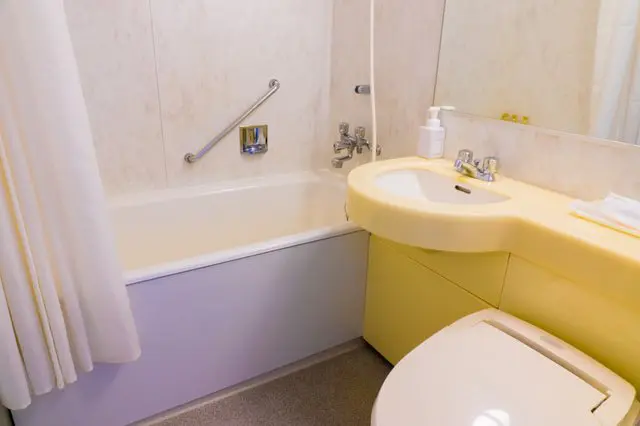
Photo by Pixta
The toilet and bathtub are located in the same area in a unit bath.
Hotel bathrooms are fitted with a shower, but it can only be used while in the bathtub. Also, leaving the bathroom door open while you take a shower may cause the fire alarm to go off, so please be sure to close the door. It's probably a good idea to pull the shower curtain across when using the shower, to avoid showering the rest of the bathroom, including the toilet seat.
5. How to Flush

In Japan, there are different flushing methods depending on the type of toilet.
If it’s a tank-type toilet, you can flush the toilet by using the handle to the side of the tank. In public facilities, traditional style Japanese toilets, or toilets that do not have a tank, you can flush the toilet by pulling the lever at the back of the toilet.
There are also models where the toilet can be flushed by pressing a button on the wall or hovering your hand over a sensor.

Photo by Pixta
A TOTO toilet can seem complicated, but the buttons are straightforward. Flushing is done via a lever or buttons for large (大) and small (小) flushes, and some models flush automatically. Other features include a heated seat, a dryer, and a Sound Princess to mask noise. Once you know the key symbols, using it is simple and efficient. Its important to know that other modern toilets also automatically flush when standing up.
6. Japanese Toilet Paper
Toilet paper is used in Japan, even by those who own toilets with bidets and washlet functions (see below).
In Japan, toilet paper is thrown directly into the toilet after use. However, please be sure to put just the toilet paper provided in the toilet. Everything else should be placed into the small trashcan located within the cubicle.
Please check the area around the toilet for anything you may have dropped, and don't forget to flush it so that it can be used by the next person.
7. How to Use Washlets and Bidets on Toilets
One thing you should definitely try out when using Japanese toilets is the washlet bidet function. Although not available with all toilets, these functions are common in Japan. Toto is the most famous brand offering washlet and bidet technology.
They allow you to wash in warm water, and also keeps the toilet seat heated. A power-saving function is also included. It instantly heats up the seat when in use and makes the water warmer only when the toilet is in use.
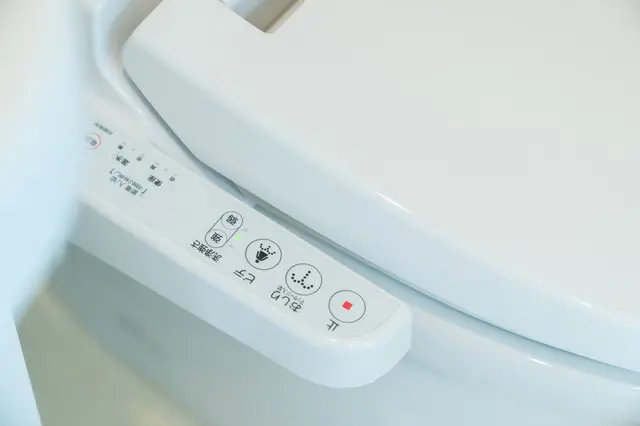
Photo by Pixta
8. How to Read the Washlet Buttons
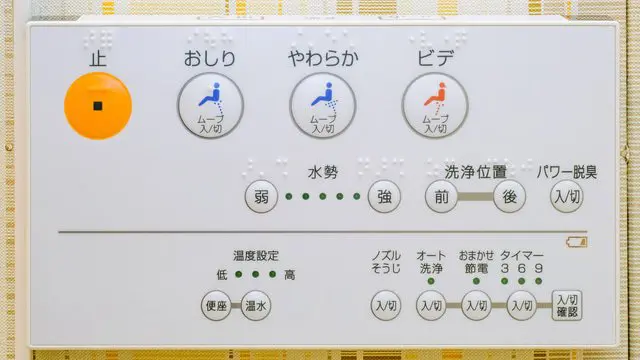
Photo by Pixta
You can use the washlet by accessing the control buttons on the side of the toilet itself. If the control pad is not set on the toilet, you can use the remote control pad on the wall. The pictures below show the different functions of each button.
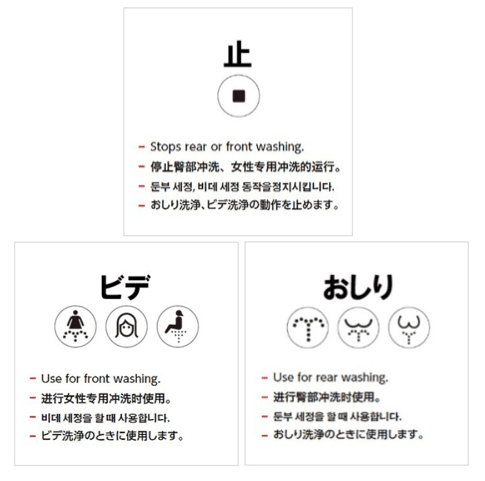
9. Flushing Water Sound Simulator

In Japan, in order to drown out the sound of you going about your business, there is a function that simulates the sound of flushing water. Sometimes this sound automatically starts playing when it detects that somebody has entered the cubicle. Other times, you might have to push a button to start the sound simulator. Although they might appear quite similar, this button is different from the flush button, so please take care not to confuse the two.
10. Emergency Call Button
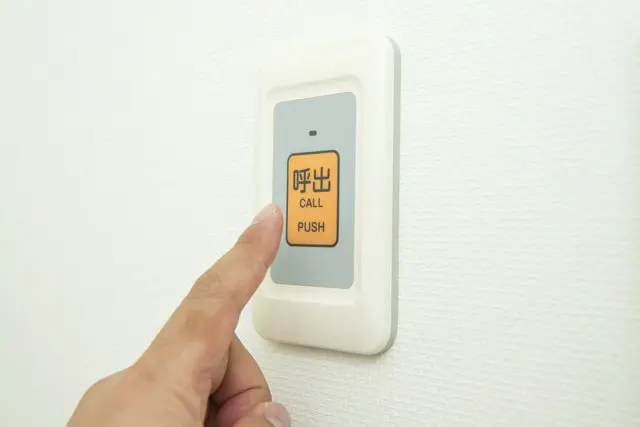
Photo by Pixta
Some toilets are provided with an emergency call button, which can be found next to the flush button. It is intended to be used by people with disabilities, or if you suddenly become sick while on the toilet. It reads "yobidashi" and will alert someone, so please be sure not to use this function except in the case of an emergency.
Read also
FAQ
What is so special about a Japanese toilet?
Japanese toilets are renowned for their advanced features, including bidet functions, heated seats, air deodorizers, sound effects for privacy, automatic functions like lid opening/closing, flushing, and seat lifting, as well as energy-efficient designs. These high-tech innovations enhance comfort, cleanliness, and convenience, reflecting Japan's commitment to innovation and efficiency in daily living.
Is it OK to flush toilet paper in Japan?
In most modern and urban areas of Japan, it is generally acceptable to flush toilet paper down the toilet. Japanese plumbing systems are designed to handle toilet paper, and you will find signs or instructions indicating that it is safe to do so in most restrooms. However, in some older or rural locations, especially in public facilities, you may encounter signs advising against flushing toilet paper due to older plumbing systems that may not be equipped to handle it. In such cases, there will usually be a wastebasket provided for the disposal of used toilet paper. It's always best to follow the guidelines provided in each specific restroom to avoid any plumbing issues.
What's the difference between a Japanese toilet and a bidet?
Japanese toilets integrate advanced bidet functions with additional features like heated seats and automated functions in an all-in-one design. They offer customizable settings and a comprehensive bathroom experience. In contrast, bidets are standalone fixtures specifically designed for post-toilet cleansing, focusing primarily on basic water cleansing without the advanced features found in Japanese toilets.
Why are Japanese toilets so advanced?
Japanese toilets are advanced due to a combination of factors: a cultural emphasis on hygiene and cleanliness, technological innovation, customer expectations for quality products, efficiency and sustainability features, and the global appeal of Japanese toilet technology. These high-tech toilets offer comfort, convenience, and enhanced hygiene, reflecting Japan's commitment to innovation and meeting the needs of consumers both domestically and internationally.
Are Japanese toilets hygenic?
Japanese toilets are recognized for their high level of hygiene due to features like bidet functions, adjustable settings for water pressure and temperature, heated seats, air deodorizers, touchless operation, and self-cleaning functions. These advanced features and design elements contribute to a clean and sanitary restroom experience, enhancing user comfort and promoting cleanliness in Japanese toilets.
Do you wipe before using a Japanese toilet?
In Japanese toilets with bidet functions, it is not necessary to wipe before using the bidet feature for personal cleaning. The bidet feature is designed to provide a thorough cleansing using water, eliminating the need for wiping with toilet paper beforehand. Users can adjust the water pressure and temperature according to their preferences for a comfortable and effective cleaning experience. The combination of bidet functions and adjustable settings in Japanese toilets allows for comprehensive personal hygiene without the need for wiping before using the bidet.
What are the disadvantages of Japanese toilets?
Japanese toilets, while innovative and feature-rich, come with potential drawbacks such as complexity in operation, installation and maintenance costs, reliance on electricity, a learning curve for users, space considerations, and environmental impact concerns regarding energy usage and water consumption. Despite these disadvantages, the comfort, hygiene, and convenience they offer make Japanese toilets a popular choice for many users.
Hello, I'm Keisuke. living Asakusa Tokyo Japan. Love triathlon(Ironman), traveling, reading, eating and my job. I really really like Japan but I think Japan should be more kindly to traveler. https://www.facebook.com/keisukeyamada84













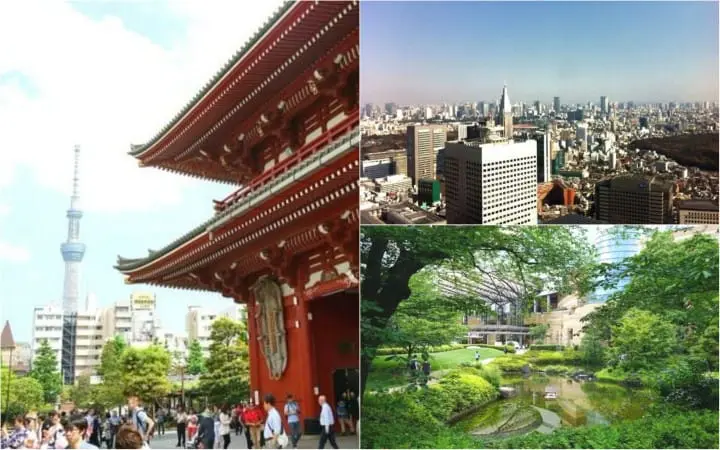



























![[2026] Top 5 Strawberry Picking Spots in Tokushima, Naruto| Farms and Access Guide for January to May](https://resources.matcha-jp.com/resize/720x2000/2025/03/06-227165.webp)
![[Yamanashi/ Hokuto City] 4 Hot New Spots Opening in 2026](https://resources.matcha-jp.com/resize/720x2000/2025/12/12-252747.webp)


